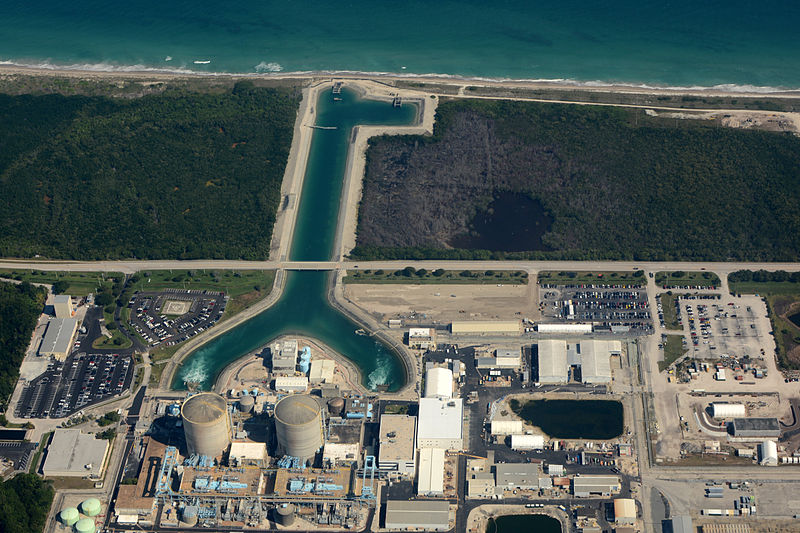A screenshot of Illinois legislators before session from an August 17 video of the Chicago Tonight television program. (Source: YouTube)
Yesterday, a television news program, Chicago Tonight, shined the spotlight on the financial troubles and potential shutdown of two of Illinois’s six nuclear power plants. The host of the show introduced the issue by stating, “Illinois lawmakers may be back in Springfield [the state’s capital] soon for a second extra session [to] strike a deal on a massive energy package.” Readers of Nuclear News might be thinking, “It’s about time!”
A still image from a three-part video tour of NuScale’s facilities. (Photos: NuScale Power)
NuScale Power has signed a memorandum of understanding with Xcel Energy to explore the feasibility of the utility’s serving as a plant operator at NuScale plants, the Portland, Ore.-based small modular reactor developer announced earlier this week.
Xcel owns and, through subsidiary Northern States Power Company, operates Minnesota’s two nuclear plants, Monticello and Prairie Island. The Monticello facility houses one 671-MWe boiling water reactor, while Prairie Island has twin 550-MWe pressurized water reactors.
A color-enhanced photograph of the NIF target bay. (Photo: LLNL/Damien Jemison)
Lawrence Livermore National Laboratory is celebrating the yield from an experiment at the National Ignition Facility (NIF) of more than 1.3 megajoules of energy—eight times more than the yield from experiments conducted this spring and 25 times more than NIF’s 2018 record yield.
The magnet system of Wendelstein 7-X features 50 superconducting magnet coils. (Graphic: IPP)
The Max Planck Institute for Plasma Physics (IPP) was founded in Garching, Germany, in 1960, the same year that its Wendelstein 1a stellarator began operation. Wendelstein 7-X is now operating at IPP’s site in Greifswald, Germany, and one of the objectives the device was designed to achieve has recently been confirmed, IPP announced on August 12. Analysis by IPP scientists shows that the twisted magnetic coils of the device successfully control plasma energy losses, indicating that stellarator fusion devices could be suitable for power plants, according to a detailed analysis of experimental results published on August 11 in Nature.
St. Lucie nuclear power plant. (Photo: D Ramey Logan)
Florida Power and Light Company, a subsidiary of NextEra Energy, has filed a subsequent license renewal application with the Nuclear Regulatory Commission for the two-unit St. Lucie nuclear power plant, seeking a second 20-year renewal of the reactors’ operating licenses.
(Source: Screen shot from YouTube video)
While it has been known for decades that bacteria known as Geobacter could clean up uranium waste, researchers at Michigan State University recently uncovered the biological mechanism behind the bacteria’s ability to do it.
The 67th president of the American Nuclear Society looks to expand the Society’s outreach across the nuclear spectrum.
If there’s one thing Steven Nesbit enjoys in life, it’s the challenge brought on by change. Whether that means growing up as a self-described “Marine brat” and moving five times before junior high school or transitioning in his professional career from the engineering side of the nuclear industry to the spent fuel and policy-driven side, Nesbit welcomes change. “I don’t mind turning the crank for a while, but I like to learn new things, and the best way to do that is to do new things.”
Rensselaer Polytechnic Institute (Photo: RPI)
Rensselaer Polytechnic Institute will use $1.5 million in grants from the Department of Energy to lead projects aimed at upgrading nuclear power plant efficiency and safety, the university announced earlier this month. The grants are part of more than $61 million in awards recently announced by the DOE to support nuclear energy research.
Hope Creek nuclear power station.
In the latest step toward its recently stated goal of achieving net-zero carbon emissions by 2030, Newark, N.J.–based Public Service Enterprise Group, owner of the Hope Creek and Salem nuclear plants, has entered into an agreement to sell its 6,750-MW fossil generating portfolio to newly formed subsidiaries of ArcLight Energy Partners Fund VII—a fund controlled by ArcLight Capital Partners. (ArcLight Capital is a Boston-based private equity firm, founded in 2001 and focused on energy infrastructure investments.) The $1.92 billion deal, announced by PSEG on August 12, is expected to be completed late in the fourth quarter of 2021 or the first quarter of 2022.
Kinzinger (left) and Doyle (right).
Last week, Reps. Adam Kinzinger (R., Ill.) and Mike Doyle (D., Pa.) introduced legislation that would establish a financial credit program for economically challenged nuclear power plants and would authorize funding for “nuclear closure communities.”
The Preserving Existing Nuclear Energy Generation Act (H.R. 4960) is the House companion to certain provisions in a Senate proposal that was reported favorably by the Senate Energy and Natural Resources Committee on July 14 and was subsequently included in the Infrastructure Investment and Jobs Act, the $1.2 trillion bipartisan package that the Senate passed earlier this week via a 69–30 vote.







 Carbon emission reductions from the power sector are likely to flatline after 2025 unless clean energy innovations and net-zero commitments from utilities pick up steam, concludes a report out this month from ClearPath, a conservative, Washington, D.C.–based clean energy nonprofit organization.
Carbon emission reductions from the power sector are likely to flatline after 2025 unless clean energy innovations and net-zero commitments from utilities pick up steam, concludes a report out this month from ClearPath, a conservative, Washington, D.C.–based clean energy nonprofit organization.












